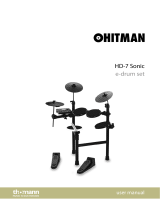
2
Contents
Getting Ready
........................................ 4
:
An Overview of the TD-50X
........................... 4
Drum Kits .............................................. 4
Memories .............................................. 5
:
Turning the Power On/O
............................ 12
Making the Power Automatically Turn O After a Time
(AUTO OFF) ............................................... 13
:
Making Hi-Hat Settings
............................... 13
Performing
............................................ 16
:
Drum Kits and Instruments
........................... 16
:
Selecting a Drum Kit
.................................. 16
Selecting a Drum Kit from the List ......................... 16
Using a Cross-Stick Technique............................. 17
Stopping All Currently Played Sounds
(ALL SOUND OFF) ........ 17
:
Using the Click
........................................ 17
:
Performing Along with a Song
........................ 18
Playing Along with a Song on an Audio Player .............. 18
Playing Along with the Songs on the TD-50X ............... 18
Repeatedly Playing a Specied Region
(A-B Repeat)............ 19
Changing the Settings for Each Song ...................... 20
Playing Back a Audio File as a Click
(Click Track)................ 21
:
Rhythm Training (Coach Mode)
.......................... 21
Correctly Playing in Time with the Beat
(TIME CHECK) .......... 21
Developing Internal Timing Sense
(QUIET COUNT) ............. 22
WARM UPS ............................................. 23
:
Registering/Recalling Your Favorite Drum
Kits (FAVORITE)
.......................................... 24
Recording
.............................................. 25
:
Recording a Performance
............................. 25
Recording Your Performance Along with a Song............. 25
Deleting Your Recorded Data ............................. 26
Naming Your Recorded Data .............................. 26
Exporting the Recorded Data to an SD Card
(SONG EXPORT) .... 26
Connecting and Recording to Your Computer............... 27
Customizing the Kits
................................ 28
:
Editing Instruments (INSTRUMENT)
...................... 28
Selecting the Instruments ................................ 28
Selecting the Pad to Set .................................. 29
Previewing the Pad Sounds
([PREVIEW] Button) ................ 29
Listening Only to the Currently-Selected
Instrument
(LAYER PREVIEW) ................................ 29
Adjusting the Attack and Release
(TRANSIENT) ................ 30
Layering Instruments
(SUB INSTRUMENT) ...................... 30
Listening Only to the Currently-Selected
Instrument
(LAYER PREVIEW) ................................ 31
:
Recreating the Reverberations of a Performance
Location
(AMBIENCE)
.................................... 32
:
Editing the Mixer (MIXER)
.............................. 32
Setting the Volume and Pan for Each Pad................... 32
Applying Eects......................................... 33
Adjusting the Overall Sound of the Drum Kit
(MASTER COMP/MASTER EQ)................................... 34
:
Comparing with or Reverting to the Unedited Drum
Kit (SNAPSHOT)
.......................................... 35
:
Editing a Drum Kit (MENU)
............................. 36
Setting the Volume ...................................... 36
Setting the Illumination Colors for the [KIT] Button and Knobs 36
Changing a Drum Kit Name............................... 36
Playing with Brushes..................................... 37
Setting a Tempo for Each Drum Kit ........................ 37
Setting a Font for Each Kit ................................ 37
Controlling the Changes in the Sound ..................... 38
Making MIDI Transmit/Receive Settings for Each Pad......... 39
:
Importing and Playing Audio Files (USER SAMPLE)
....... 39
Importing an Audio File
(IMPORT)........................... 39
Bulk Import of Audio Files Within a Folder
(IMPORT ALL) ........ 40
Assigning a User Sample to an Instrument and Playing It ..... 40
Listing the User Samples ................................. 41
Specifying How the User Sample Is Sounded................ 41
Specifying the Sounded Region of a User Sample ........... 41
Deleting a User Sample .................................. 41
Renaming a User Sample ................................. 42
Organizing User Samples................................. 42
Using the Utilities
.................................... 43
:
Connecting to Your Computer
........................ 43
Installing/Setting Up the USB Driver ....................... 43
Conguring the Output for USB Audio ..................... 44
Specifying the Input for USB Audio ........................ 44
Conguring the Routing for USB Audio
(Audio Routing)......... 45
:
Copying Settings (COPY)
............................... 45
:
Recalling Drum Kits Successively (SET LIST)
............. 47
Creating a Set List ....................................... 47
Using Set Lists .......................................... 48





















